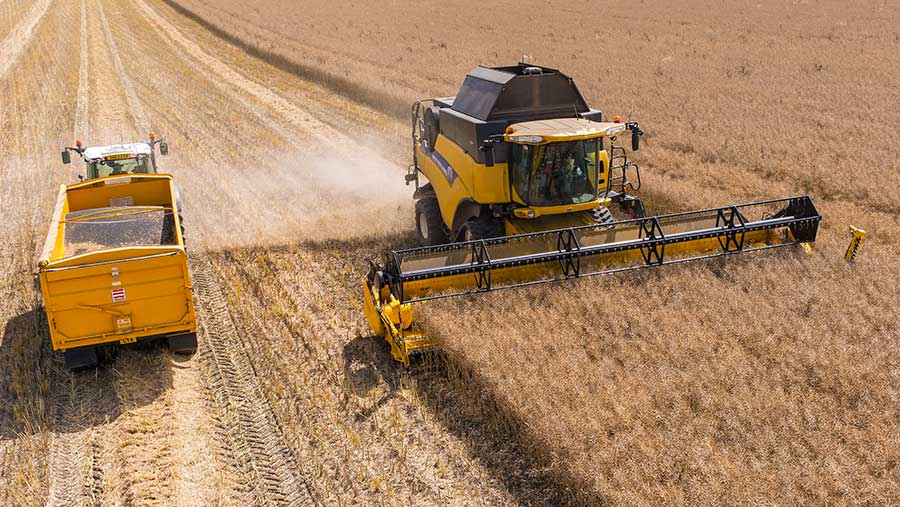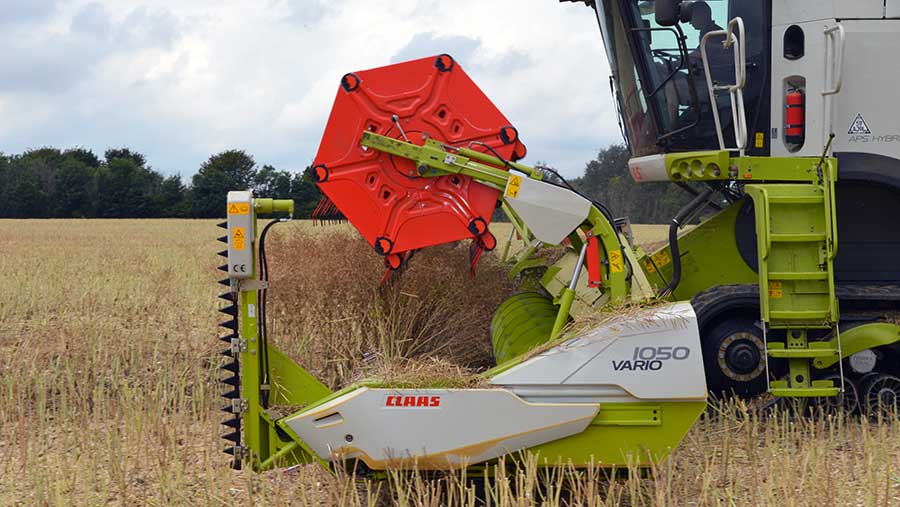Harvest 2017 video: OSR growers optimistic as wheat is cut
 © Tim Scrivener
© Tim Scrivener Oilseed rape yield prospects are being edged higher as combines plough through early-maturing crops, while the winter wheat harvest is kicking off with grain quality looking good.
With many rapeseed crops showing yields above 4t/ha there is growing optimism over the harvest with crops further west outpacing the yield of those hit by pests and drought in the east.
Many oilseed rape growers outside East Anglia have fared better than expected with fewer cabbage stem flea beetle problems and better rainfall levels.
See also: Harvest 2017: Drought hits crop yields on lighter land
Meanwhile, combines have started to move into winter wheat in southern England with milling quality looking good, while yields are slightly lower due to the hot weather in June.
Very early crops of milling wheat in Cambridgeshire are showing proteins and specific weights above industry standards after being harvested on light sandy land.

Farm manager Scott Bagwell © David Jones/RBI
Dorset yields
Down in Dorset, farm manager Scott Bagwell has finished cutting 138ha of oilseed rape with an average yield of 4.4t/ha helped by good spring sunlight and as his crops escaped drought and flea beetle attacks.
Yields started at 4.2t/ha but moved up to 4.9t/ha on more fertile land on his chalky soils at Field Barn Farm, Winterborne Whitechurch, six miles south-west of Blandford Forum.
“We had very good establishment in the autumn, a mild winter and the crop was almost too vigorous,” he told Farmers Weekly.
Mr Bagwell started cutting the variety Elgar on 8 July and finished a week later on 15 July on the 860ha arable and grassland farm, and he is now moving into spring barley.
Average rapeseed yields on his chalky soils range from 3.8t/ha to 4.5t/ha over the past few years, helped by area’s rainfall, which at about 925mm is higher than the East of England, where in parts of Essex it can dip below 500mm.

Grower Sam Burge © Oli Hill/RBI
Hampshire smiles
Over in Hampshire, the oilseed rape harvest is bringing a smile to Sam Burge’s face as his yields were hitting 4.5t/ha on his farm just outside Winchester.
His hopes had been low after a “bone dry” season, but when Mr Burge started combining 35ha of the variety Barbados on 14 July at 8% moisture, he was pleasantly surprised.
Watch the video report on Vale Farm’s early oilseed rape yields below.
Initially the crop was yielding 4.2t/ha, which is average for the farm, but once the whole crop was put over the weighbridge the figures were better than Mr Burge anticipated.
“As a variety Barbados has been great to grow, it has been bone dry this season and I’m really pleased. This year nothing looks too sensational, but it’s better than last year,” he said.
Mr Burge farms as part of family partnership at Vale Farm on the edge of the South Downs some 10 miles from the English south coast.
Encouraging Oxfordshire harvest
Further north, Oxfordshire grower Jonny Edwards reported encouraging yields on his oilseed rape averaging 3.5t/ha after a desperately dry year at Coldharbour Farm in Crowmarsh.
He farms 485ha on the edge of the Chilterns, 12 miles north of Reading, and has 85ha of the variety Elgar. The combine started cutting on 14 July at 8.5% moisture, with yields on the lighter, chalky upland coming off at 3.2t/ha.
Once he moved on to more fertile silty land towards the River Thames this figure rose to 3.7t/ha, giving a weighbridge average yield of 3.5t/ha.
Watch the video of day 1 of the oilseed rape harvest at Coldharbour Farm in Oxfordshire below.
“We’ve had a dry season so we are happy with that, it’s about average for the farm so far but I expect yields to get better as we move over on to better ground. The chalk never lets us down as it hold a bit of moisture,” he added.
Yield upgrades
These impressive yields are prompting Owen Cligg, trading manager at United Oilseeds to raise his forecast of nationwide yields to 3.8t/ha from his previous estimate of 3.6t/ha compared with 3.1t/ha last year.
“It will not be a bumper crop but we are quietly optimistic that yields will be closer to 4t/ha than 3t/ha,” he told Farmers Weekly.
Mr Cligg has penciled in yields of just over 4t/ha for south-east England and down to 3.5t/ha in the east of England.

© David Jones/RBI
Over in the East, Philip Darke, managing director of grain co-operative Camgrain was more optimistic over crops in his area. He said its members were seeing yields of 4.25t/ha and above.
“We lost a lot of oilseed rape in Essex due to dry weather, but crops are surprisingly tolerant and growers are quite pleased with yields,” he said.
Cambridgeshire yields
Farm manager John Payne at farming company GW Topham in Cambridgeshire reported yields of 4.0-4.25t/ha as he moved through the group’s 680ha of oilseed rape.
“After the early pressures of flea beetle the yields are better than we thought back in November,” he said.
Farming in the west of the county between Camborne and St Neots, yields at these levels are matching those seen in recent years.
Watch the latest harvest 2017 videos
Early wheat
Very early-maturing crops of milling winter wheat in Cambridgeshire are showing good grain quality even though yields are struggling to match previous years.
David White, farming between Cambridge and Newmarket on some sandy land cut 14ha of the older milling variety Solstice on 17 July and reported proteins over 13% and a specific weight of 77-78kg/hl.

© David Jones/RBI
Yields were coming in at 8t/ha compared with 9t/ha he usually expects, and this lower yield was largely due to the very hot spell of weather in June.
“Quality is good, but there is not as much grain as we would have liked,” he said.
He also cut some 8ha of the milling variety Crusoe early this week with similar yields and quality to the Solstice, while he has 40-45ha of wheat to cut in total.
Typical minimum wheat industry milling specifications are looking for protein content of 13%, specific weight of 76kg/hl and Hagberg level of 250.
Barley disappoints
The winter barley harvest is well under way across most of southern England, with quality general good but yields tending to disappoint.
James Peck, farming at Dry Drayton just west of Cambridge, reported yields of the six-row hybrid variety Volume at 8.2t/ha, whereas he would normally expect more than 9t/ha.
Back in Oxfordshire, Mr Edwards cut 46ha of another six-row hybrid Bazooka for the first time and hit an average yield of 8.1t/ha.
See also: The latest harvest 2017 coverage
Over in Hampshire, Mr Burge was disappointed with yields from his 31ha of old special malting variety Maris Otter.
“We’ve had 7.5t/ha in a good year and 5.5t/ha in a bad year and I think we are nearer a bad year,” noted Mr Burge. This falls below the farm’s long-term average of about 6t/ha.
However, it earns a £50/t premium over feed barley and is sold to local merchant Robin Appel on a malting contract.
Harvest 2017: how to get involved
Make sure you are up to date with all the latest harvest 2017 developments by following Farmers Weekly’s Harvest Live Twitter account, liking our Facebook page, and following us on Instagram.
You can get all the news and analysis on the harvest page of the Farmers Weekly website.
To add your snaps to our Harvest 2017 gallery on Facebook, just message or email us with your name, where you’re from and a line telling us what’s going on.
Throughout harvest. we will aim to use as many of your photos in the magazine and online as possible.

